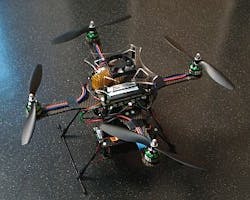Micro air vehicle maneuvers in disaster areas and rescue missions
The most important task in hazardoussearch-and rescue missions is to narrow down the search area and guide rescue workers to the right location. The rescuers also need to know the inner state of the building to assess the damage, anticipate likely risks, and determine the best rescue strategy. Any ground-based robotic device that is sent into the damaged area to obtain this information is likely to be impeded by rubble.
A tiny unmanned aerial vehicle in helicopter form -- known as a micro air vehicle (MAV) -- has been developed and reported by the team of Lorenz Meier, Friedrich Fraundorfer, and Marc Pollefeysto at the Computer Vision and Geometry Laboratory (Department of Computer Science, ETH Zurich, Switzerland) to aid in either civilian or militarysearch-and-rescue missions in hazardous environments. The four-rotor PIXHAWK Cheetah MAV, with onboard intelligence and autonomous-navigation capabilities, is 55 cm in diameter, measured across its rotor blades. Powered by lithium polymer batteries, the Cheetah can fly for up to 12 min. It features four cameras with flexible mountings and an onboard image-processing computer. The Cheetah's computer-vision system enables it to assess and solve navigational problems with no outside help.
The advantages of the MAV are its vertical degrees of freedom, allowing it to evade obstacles by changing altitude and use vertical spaces to access damaged levels as well as ensure structure stability. The Cheetah’s onboard PIXHAWK software storesstereo-vision images on a central image hub; they can be read by different image-processing pipelines in parallel. The system can also detect and track objects by adjusting a camera's field of view to keep a particular object in sight.
SOURCE: SPIE [13 January 2011, SPIE Newsroom. DOI: 10.1117/2.1201012.003392]
For more information,see the full report in SPIE’s newsroom.
-- Posted byVision Systems Design

